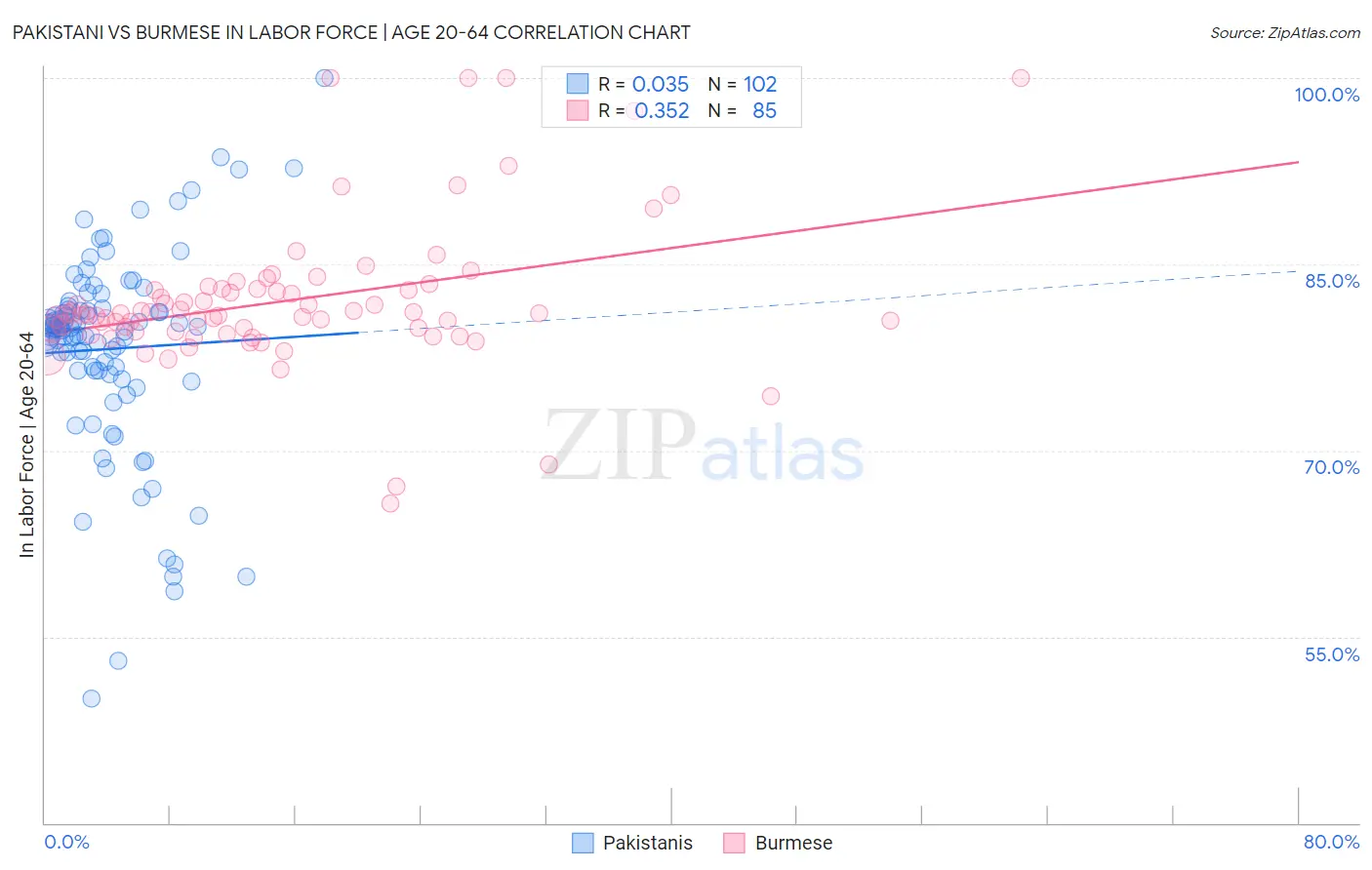Pakistani vs Burmese In Labor Force | Age 20-64
COMPARE
Pakistani
Burmese
In Labor Force | Age 20-64
In Labor Force | Age 20-64 Comparison
Pakistanis
Burmese
79.8%
IN LABOR FORCE | AGE 20-64
79.3/ 100
METRIC RATING
145th/ 347
METRIC RANK
80.3%
IN LABOR FORCE | AGE 20-64
98.8/ 100
METRIC RATING
61st/ 347
METRIC RANK
Pakistani vs Burmese In Labor Force | Age 20-64 Correlation Chart
The statistical analysis conducted on geographies consisting of 335,365,372 people shows no correlation between the proportion of Pakistanis and labor force participation rate among population between the ages 20 and 64 in the United States with a correlation coefficient (R) of 0.035 and weighted average of 79.8%. Similarly, the statistical analysis conducted on geographies consisting of 465,432,233 people shows a mild positive correlation between the proportion of Burmese and labor force participation rate among population between the ages 20 and 64 in the United States with a correlation coefficient (R) of 0.352 and weighted average of 80.3%, a difference of 0.62%.

In Labor Force | Age 20-64 Correlation Summary
| Measurement | Pakistani | Burmese |
| Minimum | 50.0% | 65.7% |
| Maximum | 100.0% | 100.0% |
| Range | 50.0% | 34.3% |
| Mean | 78.2% | 82.1% |
| Median | 79.8% | 81.0% |
| Interquartile 25% (IQ1) | 76.4% | 79.5% |
| Interquartile 75% (IQ3) | 81.4% | 83.1% |
| Interquartile Range (IQR) | 5.0% | 3.5% |
| Standard Deviation (Sample) | 8.2% | 6.0% |
| Standard Deviation (Population) | 8.1% | 6.0% |
Similar Demographics by In Labor Force | Age 20-64
Demographics Similar to Pakistanis by In Labor Force | Age 20-64
In terms of in labor force | age 20-64, the demographic groups most similar to Pakistanis are Korean (79.8%, a difference of 0.0%), Immigrants from Southern Europe (79.8%, a difference of 0.0%), Immigrants from South Eastern Asia (79.8%, a difference of 0.010%), Immigrants from Israel (79.8%, a difference of 0.010%), and Slovak (79.8%, a difference of 0.010%).
| Demographics | Rating | Rank | In Labor Force | Age 20-64 |
| Immigrants | Nigeria | 86.4 /100 | #138 | Excellent 79.9% |
| Immigrants | Spain | 83.9 /100 | #139 | Excellent 79.8% |
| Immigrants | South Eastern Asia | 80.4 /100 | #140 | Excellent 79.8% |
| Immigrants | Israel | 80.0 /100 | #141 | Good 79.8% |
| Slovaks | 79.9 /100 | #142 | Good 79.8% |
| Immigrants | Sweden | 79.7 /100 | #143 | Good 79.8% |
| Koreans | 79.6 /100 | #144 | Good 79.8% |
| Pakistanis | 79.3 /100 | #145 | Good 79.8% |
| Immigrants | Southern Europe | 78.9 /100 | #146 | Good 79.8% |
| Immigrants | Philippines | 78.0 /100 | #147 | Good 79.8% |
| Romanians | 77.6 /100 | #148 | Good 79.8% |
| Icelanders | 75.1 /100 | #149 | Good 79.7% |
| Costa Ricans | 72.4 /100 | #150 | Good 79.7% |
| Scandinavians | 72.0 /100 | #151 | Good 79.7% |
| Immigrants | Northern Europe | 72.0 /100 | #152 | Good 79.7% |
Demographics Similar to Burmese by In Labor Force | Age 20-64
In terms of in labor force | age 20-64, the demographic groups most similar to Burmese are Tongan (80.3%, a difference of 0.0%), Carpatho Rusyn (80.3%, a difference of 0.0%), Serbian (80.3%, a difference of 0.010%), Swedish (80.3%, a difference of 0.010%), and Immigrants from Korea (80.3%, a difference of 0.010%).
| Demographics | Rating | Rank | In Labor Force | Age 20-64 |
| Peruvians | 99.1 /100 | #54 | Exceptional 80.3% |
| Immigrants | Cabo Verde | 99.0 /100 | #55 | Exceptional 80.3% |
| Immigrants | Northern Africa | 99.0 /100 | #56 | Exceptional 80.3% |
| Afghans | 98.9 /100 | #57 | Exceptional 80.3% |
| Serbians | 98.9 /100 | #58 | Exceptional 80.3% |
| Swedes | 98.9 /100 | #59 | Exceptional 80.3% |
| Tongans | 98.8 /100 | #60 | Exceptional 80.3% |
| Burmese | 98.8 /100 | #61 | Exceptional 80.3% |
| Carpatho Rusyns | 98.8 /100 | #62 | Exceptional 80.3% |
| Immigrants | Korea | 98.8 /100 | #63 | Exceptional 80.3% |
| Immigrants | Albania | 98.7 /100 | #64 | Exceptional 80.3% |
| Lithuanians | 98.7 /100 | #65 | Exceptional 80.2% |
| Macedonians | 98.7 /100 | #66 | Exceptional 80.2% |
| Taiwanese | 98.6 /100 | #67 | Exceptional 80.2% |
| Bhutanese | 98.6 /100 | #68 | Exceptional 80.2% |